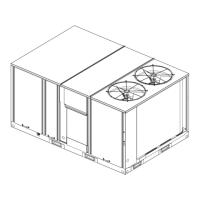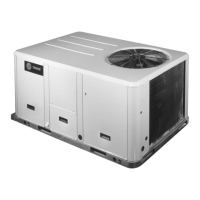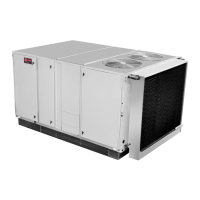Start Up
RT-SVX25G-EN 37
2. After the compressor and condenser fan have started
and operated for approximately 30 minutes, observe
the operating pressures. Compare the operating
pressures to the operating pressure curve in the
Service Facts.
3. Check system subcooling. Follow the instruction listed
on the subcooling charging curve in the Service Facts.
4. Repeat Step 1 through Step 3 for each refrigerant
c
ircuit.
5. To stop the SERVICE TEST, turn the main power
disconnect switch to the “Off” position or proceed to
the next component start-up procedure. Remove
electro mechanical test mode connections (if
applicable).
Dehumidification Option
Momentarily jump across the Test 1 and Test 2 terminals of
the LTB1 until the unit enters test mode 7. (
Table 8, p. 35)
Once the unit is in the reheat test mode, verify that the
three-way valve has shifted to the reheat position and that
the supply temperature rises 10°F more than when in
cooling mode stage 2. Monitor the suction pressure for 15
minutes. The suction pressure should remain within 5 psi
of normal cooling operation.
Heating Start-Up
1. Clamp an amp meter around one of 1
st
stage heater
power wires at the heater contactor.
2. ReliaTel Control Using the Service Test Guide in
Table 8, p. 35, continue the SERVICE TEST start-up
p
rocedure for each compressor circuit.
Momentarily jump across the Test 1 and Test 2
terminals on LTB one additional time if continuing
from previous component start-up or until the desired
start-up component test is started.
3. Verify that the heater stage is operating properly.
4. Clamp an amp meter around one of 2
nd
stage heater
power wires at the heater contactor (if applicable).
5. ReliaTel Control Using the Service Test Guide in
Table 8, p. 35, continue the SERVICE.
6
. TEST start-up procedure for each compressor circuit.
Momentarily jump across the Test 1 and Test 2
terminals on LTB one additional time if continuing
from previous component start-up or until the desired
start-up component test is started.
7. Verify that the heater stage is operating properly.
8. To stop the SERVICE TEST, turn the main power
disconnect switch to the “Off” position or proceed to
the next component start-up procedure. Remove
electro mechanical test mode connections (if
applicable).
Variable Air Volume Applications
(Multi-zone, Traditional VAV)
Supply Air Temperature Control -
Occupied Cooling and Heating
The RTRM is designed to maintain a selectable supply air
temperature of 40ºF to 80ºF with a +/- 3.5ºF deadband. To
reduce the risk of coil freezing, it is not recommended to
set the supply air temperature below 50ºF. In cooling
mode, if the supply air temperature is more than 3.5ºF
warmer than the selected temperature, a stage of cooling
will be turned ‘on’ (if available). Also, if the supply air
temperature is more than 3.5ºF cooler than the selected
temperature, a stage of cooling will be turned ‘off’. At very
low airflow, the unit may cycle stages ‘on’ and ‘off’ to
maintain an average discharge air temperature outside the
7 degrees deadband.
The RTRM utilizes a proportional and integral control
scheme with the integration occurring when the supply air
temperature is outside the deadband. As long as the
supply air temperature is within the setpoint deadband,
the system is considered to be satisfied and no staging up
or down will occur.
Supply Duct Static Pressure Control
The supply duct static pressure is measured by a
transducer with a 0.25 to 2.125 Vdc proportional output
which corresponds to an adjustable supply duct static
pressure of 0.3" w.c. to 2.5" w.c. respectively with a
deadband adjustment range from 0.2" w.c. to 1.0" w.c. The
setpoint is adjustable on the RTAM Static Pressure
Setpoint potentiometer or through ICS.
Example:
Table 10. POE Oil recharge amount (fl. oz.)
Mo d el
C1
2 5 m m / 1 8 m m
C2
2 5 m m / 1 8 m m
TS* 150 56/ 105 .6 62/ 99.2
TH* 150 56/ 156 .8 38/ 91.2
TH* 150 Reheat 56 56
TS* 180/ 155 112/ 182.4 62 ( 62) / 96
TH* 180 102 52
TH* 180 Reheat 56 56
TSH210, TS* 175 112/ 182.4 38 (62)/ 96
TS* 210/ 17 5 112 38 ( 62)
TH* 210 114 52
TH* 210 Reheat 102 56
TS* 240/ 20 0 112 56
TH* 240 112 56
TH* 240 Reheat 112 112
TS* 300/ 25 0 112 106
TH* 300 112 56

